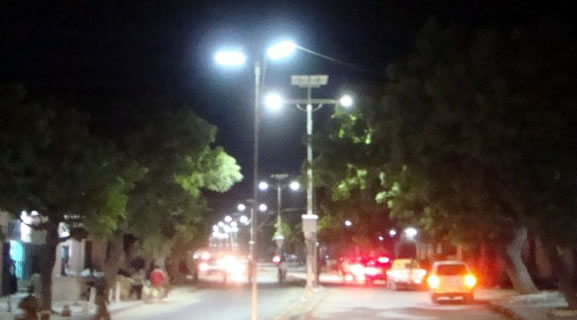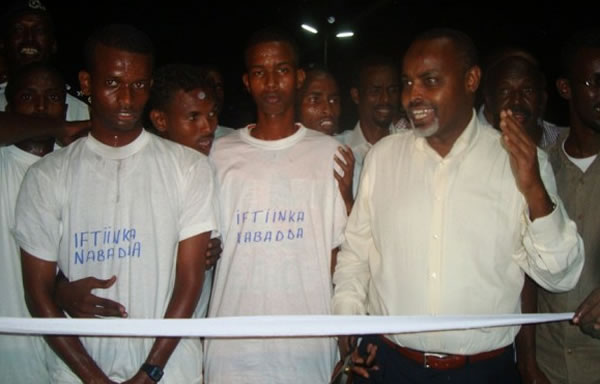
Solar powered lights illuminated Makka Mukara Street, Mogadishu, Somalia
by Muuse Yuusuf
Sunday, June 17, 2012I know the cynic and the sceptic will accuse me of having some genealogical or other interest links with the man I am going to write about, a man that Hiiraan.com had already chosen as the person of the year 2011.
From the beginning, let me make it clear: I do not have any business or other political association with Mohamed Nur aka “Tarzan”, the mayor of Mogadishuexcept a very few brief encounters at some Somali meetings inLondon.
However and paradoxically I must say I do have some deeper connection with Tarzan that goes beyond tribal or other association! The mayor and I have lived inLondonalmost 20 years although in different parts. We have experienced the changing face of this metropolitan city. We came to this city after the Docklands in the eastern part ofLondonwere revived economically by the Thatcher government’s regeneration projects that secured the construction of one of Europe’s financial districts with its sky-scrapers such as theCanaryWharfbuilding, once the highest building inEurope. This urban development project has transformed this poor part ofLondonto a thriving hub of business quarter which challenged the prestige of the city ofLondon, the traditional financial market district. Besides this huge multi-million pound project, there were many more countless urban developmental projects that changed the face of many quarters of the city from poverty-ridden and recession-prone areas to thriving business communities, where people felt proud of living and working in them. Indeed, as I write this article the city is teeming up with some huge construction, financial and social enterprises as the wealthy and entrepreneur are coming from far places as Chine to invest in this proud city. Hardly a month goes by without seeing some new buildings as small districts of luxury flats sprung up in the middle of once neglected and rundown areas notorious for crime and other anti-social behaviour activities.

Tarzan brings light to Mogadishu
One particular urban regeneration project that attracted the attention of many Londoners was King’s Cross urban development projects. Once the heart and the power-house of the economic, political and social life during theBritish Empire, the area was neglected, and derelict buildings became hide-outs for gangs, drug-dealers and prostitutes. The area became synonymous with the social ills of a broken community; you were likely to be robbed while visiting the area. However, previous British governments, particularly the last Labour government injected millions of pounds in the area transforming it to a booming business quarter that is proud to hosting one of the main stations for the Euro trains that link London and the whole of the UK to the mainland Europe by land.
As well as many Londoners, including myself, the current mayor of Mogadishu “Tarzan” was impressed by these projects which probably remain a source of his inspiration that gives him the strengthen to continue with his endless efforts to rebuild one of the most dangerous cities on earth but once a beautiful metropolitan city and the pride of the Somali people. You only need to read the following statement to see how the man was inspired by this:
"I was living here when King's Cross was very dirty, with houses that were empty and run down, and lots of drug dealing, crime and prostitution. But when they regenerated it a few years ago, all that disappeared, and hotels, restaurants and shops opened. I realised that if you keep an area clean and well-lit, then a lot of bad things will disappear."
This first hand human experience is what is driving this man’s vision for regeneration and urban development plan forMogadishu. He thinks that the King’s Cross model is a blue-print for Mogadishu and if the theory of fixing “broken window” and “zero tolerance” to crime pioneered by some city mayors, such as the New York mayor, Rudolf Giuliani, has worked in King’s Cross, it should and could work for Mogadishu.
Although these two models/projects are totally different in terms of the scale and the magnitude of the task ahead and cannot be compared because one is supposed to rebuild a 2-million people metropolitan city, while the other one is to regenerate one part of a city, it is the basic theory of fixing the “broken window” which makes them equal. By “fixing the broken window” and generating the area, while discouraging criminals, you give people a new chance and hope that after all normal life is returning to the area after a long-neglect or a civil war. People then feel secure and safe, start living their lives and feel proud to be part of a thriving and safe community. If you do not tackle the underlying social ills and economic deprivation of an area, then despair, frustration and hopelessness will settle in peoples’ minds which will make them unable to see any better life beyond their current life, or as the man who is leading the regeneration has articulated:
"The problem is that today, the people have simply got used to living in violence, dirt and fear, and they cannot imagine another life. I want to change that."
Along side the King’s Cross experience, which remains one of his main inspiration, the man has other personal motives and emotions that propels him to do his job with a limited budget of only about £500,000 a year! The city he is rebuilding is the place he grew in, the city he loves, and it hurts him to see it as a ghost town destroyed by warlords as puts it:
"Mogadishuis the city I grew up in, the place I love, and it always made me angry the way the warlords cut it into fiefdoms. ..From this month on, anybody who drives in the wrong lane or with heavy loads or without lights can expect a fine... I wantMogadishuto become like a normal city again, where people cannot just be allowed to drive however they want."
The point here is that if you have experience of seeing the changing face of a great city likeLondoncombined with your personal and emotional commitment, then, there is nothing to stop you from doing your job and hopefully succeeding. And this is what the man, who was once aLondoncouncil worker has in possession.
I was actually pleased to seeMogadishustreets being lit up and glittered with solar-powered lights, which are giving the city a new lease of life. This is thanks to his efforts. Hopefully this new lease of life forMogadishuresidents is the end ofMogadishu’s long history of darkness or as the mayor himself explained:
“…. The city was full of rubbish and politicians were confined to heavily protected hotels. Now the city is almost clean, although we don’t have much equipment. The security has improved drastically. Markets are open and people are trading until 11 at night. It has changed a lot, but there remains much to be done.
In conclusion, let me add my voice to the growing voice of supportingcontinuityin which Bashir Goth has eloquently advocated for the re-election of Sheikh Sharif Sheikh Ahmed as next president post-Al-Shabaab/August. I can see the logic of his argument and I indeed support his call because sometimescontinuity fostersstabilityand this is what the Somali people need right now. A new president from another clan consideringSomalia’s treacherous clan politics would probably create more problems
And of course for the sake of continuity, I would urge the next president and his government to keep Mohamed Nur “Tarzan” as the mayor of our beloved capital city.Mogadishupeople needcontinuity and stability.
Muuse Yuusuf
[email protected]